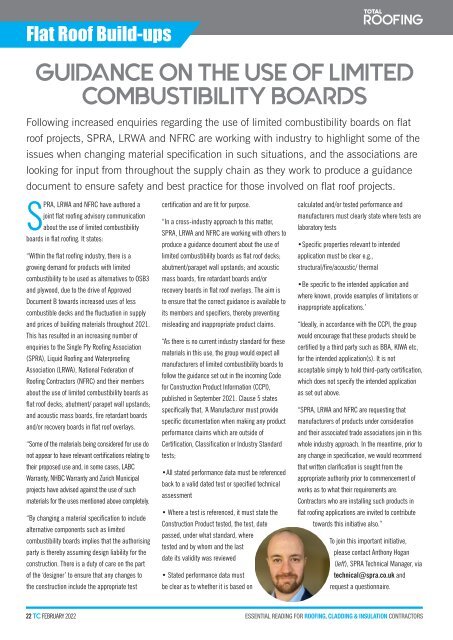February 2022
You also want an ePaper? Increase the reach of your titles
YUMPU automatically turns print PDFs into web optimized ePapers that Google loves.
Flat Roof Build-ups<br />
GUIDANCE ON THE USE OF LIMITED<br />
COMBUSTIBILITY BOARDS<br />
Following increased enquiries regarding the use of limited combustibility boards on flat<br />
roof projects, SPRA, LRWA and NFRC are working with industry to highlight some of the<br />
issues when changing material specification in such situations, and the associations are<br />
looking for input from throughout the supply chain as they work to produce a guidance<br />
document to ensure safety and best practice for those involved on flat roof projects.<br />
SPRA, LRWA and NFRC have authored a<br />
joint flat roofing advisory communication<br />
about the use of limited combustibility<br />
boards in flat roofing. It states:<br />
“Within the flat roofing industry, there is a<br />
growing demand for products with limited<br />
combustibility to be used as alternatives to OSB3<br />
and plywood, due to the drive of Approved<br />
Document B towards increased uses of less<br />
combustible decks and the fluctuation in supply<br />
and prices of building materials throughout 2021.<br />
This has resulted in an increasing number of<br />
enquiries to the Single Ply Roofing Association<br />
(SPRA), Liquid Roofing and Waterproofing<br />
Association (LRWA), National Federation of<br />
Roofing Contractors (NFRC) and their members<br />
about the use of limited combustibility boards as<br />
flat roof decks; abutment/ parapet wall upstands;<br />
and acoustic mass boards, fire retardant boards<br />
and/or recovery boards in flat roof overlays.<br />
“Some of the materials being considered for use do<br />
not appear to have relevant certifications relating to<br />
their proposed use and, in some cases, LABC<br />
Warranty, NHBC Warranty and Zurich Municipal<br />
projects have advised against the use of such<br />
materials for the uses mentioned above completely.<br />
“By changing a material specification to include<br />
alternative components such as limited<br />
combustibility boards implies that the authorising<br />
party is thereby assuming design liability for the<br />
construction. There is a duty of care on the part<br />
of the ‘designer’ to ensure that any changes to<br />
the construction include the appropriate test<br />
certification and are fit for purpose.<br />
“In a cross-industry approach to this matter,<br />
SPRA, LRWA and NFRC are working with others to<br />
produce a guidance document about the use of<br />
limited combustibility boards as flat roof decks;<br />
abutment/parapet wall upstands; and acoustic<br />
mass boards, fire retardant boards and/or<br />
recovery boards in flat roof overlays. The aim is<br />
to ensure that the correct guidance is available to<br />
its members and specifiers, thereby preventing<br />
misleading and inappropriate product claims.<br />
“As there is no current industry standard for these<br />
materials in this use, the group would expect all<br />
manufacturers of limited combustibility boards to<br />
follow the guidance set out in the incoming Code<br />
for Construction Product Information (CCPI),<br />
published in September 2021. Clause 5 states<br />
specifically that, ‘A Manufacturer must provide<br />
specific documentation when making any product<br />
performance claims which are outside of<br />
Certification, Classification or Industry Standard<br />
tests;<br />
•All stated performance data must be referenced<br />
back to a valid dated test or specified technical<br />
assessment<br />
• Where a test is referenced, it must state the<br />
Construction Product tested, the test, date<br />
passed, under what standard, where<br />
tested and by whom and the last<br />
date its validity was reviewed<br />
• Stated performance data must<br />
be clear as to whether it is based on<br />
calculated and/or tested performance and<br />
manufacturers must clearly state where tests are<br />
laboratory tests<br />
•Specific properties relevant to intended<br />
application must be clear e.g.,<br />
structural/fire/acoustic/ thermal<br />
•Be specific to the intended application and<br />
where known, provide examples of limitations or<br />
inappropriate applications.’<br />
“Ideally, in accordance with the CCPI, the group<br />
would encourage that these products should be<br />
certified by a third party such as BBA, KIWA etc,<br />
for the intended application(s). It is not<br />
acceptable simply to hold third-party certification,<br />
which does not specify the intended application<br />
as set out above.<br />
“SPRA, LRWA and NFRC are requesting that<br />
manufacturers of products under consideration<br />
and their associated trade associations join in this<br />
whole industry approach. In the meantime, prior to<br />
any change in specification, we would recommend<br />
that written clarification is sought from the<br />
appropriate authority prior to commencement of<br />
works as to what their requirements are.<br />
Contractors who are installing such products in<br />
flat roofing applications are invited to contribute<br />
towards this initiative also.”<br />
To join this important initiative,<br />
please contact Anthony Hogan<br />
(left), SPRA Technical Manager, via<br />
technical@spra.co.uk and<br />
request a questionnaire.<br />
22 TC FEBRUARY <strong>2022</strong>

















